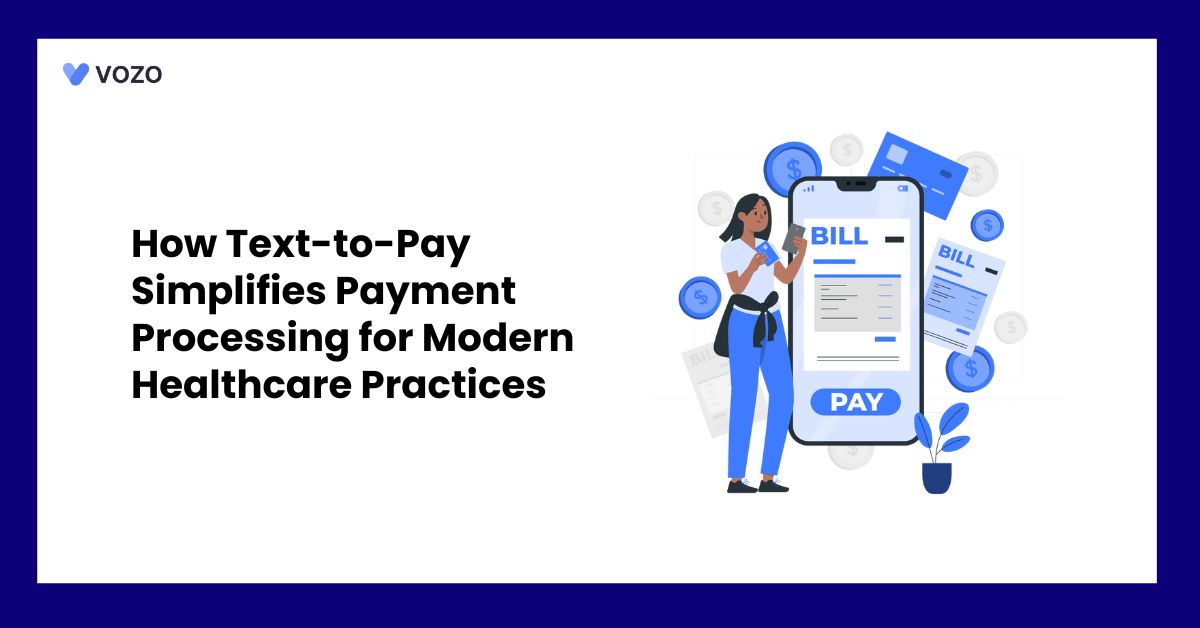How Text-to-Pay Simplifies Payment Processing for Modern Healthcare Practices
Modern healthcare faces various challenges in payment processing, such as complex regulations, multiple statements, and paper bills. Providers may lose payments due to the traditional payment method being complex, as it affects the revenue cycle.
Text-to-Pay transforms the healthcare payment process, helping providers collect payments by improving the patient experience. In this blog, you’ll learn the advantages, why practices need the text-to-pay option, and the implementation process.
What is Text-to-Pay in Healthcare?
Text-to-Pay is a secure payment technique in which medical bills are transmitted via SMS via a text message. Patients can use the link in the text message to pay using their mobile device.
This method simplifies the payment process, where they can directly pay their bills without logging into a payment system.
- The SMS message contains a secure payment link that directs you to the payment page.
- Text-to-Pay is a mobile-friendly option where patients can make payments easily via smartphones.
- This payment method increases the speed and convenience, which leads to improved response rates.
- Enhances patient engagement through real-time communication that builds trust and a patient relationship with the practice.
- Billing and payments are made faster, which reduces administrative workload and leads to an efficient billing process.
Benefits of the Text-to-Pay Method
1. Simplified Payment Process
59% of the people prefer text messages over phone calls or emails for billing notifications, as it has a simple text payment process.
Practices can automate reminders, payment processing, and generating invoices, which leads to saving time and resource utilization. Text-to-Pay format is an immediate process, and patients can pay their bills faster.
2. Communication Made Easy
In paper or electronic payments, patients forget to pay their bills, which leads to late payments. Patient satisfaction increases when physicians can better connect with patients regarding payments, thanks to the text-to-pay option. Some text-to-pay systems allow patients to send a response text message.
3. Secure Transactions
Text-to-Pay has advanced encryption and compliance, such as HIPAA, that ensures patient transactions and data are secure. It has security features like encrypted communication between patient and provider, a secure payment link, and authentication.
4. Improve Cash Flow
A survey states that 32% of people would pay their bill within 5 minutes after receiving a text notification. Integrating the SMS payment method in healthcare practice meets the payment deadlines and improves cash flow. Patients pay their bills immediately with just one tap.
Related: Top 5 Must Read Medical Billing Trends For 2025
Why Modern Healthcare Practices Need Text-to-Pay
Text-to-Pay has now become an essential component for modern healthcare providers. Patients can pay their bills on the go. This increases the demand for convenience and improves patient satisfaction.
Traditional payments in healthcare, such as mailing invoices, lead to slow turnaround times for processing mail checks. Increases manual effort for following overdue payments. It costs a lot to print and mail invoices.
The text message option offers faster payment. Practices send automated patient payment reminders and inform their deadlines without following up with a phone call.
3 Ways to Use the Text-to-Pay Method
1. Send a Payment Link
Collect medical bills via text message and provide them with a direct payment link. This link takes the user to the payment page and avoids confusion. It encourages patients to pay right away once the link is given directly to the user.
2. Text Reminders
Common reasons people fail to pay are that they forget about their medical bills. Healthcare practices send a simple text message as a reminder to inform patients about their payments due.
3. Use MMS to Send Bills
The alternative option to remind them about their bills is to send an MMS. Practices can send or receive files directly from patients. It is easy to access their bills and clear their doubts.
Related: A Provider’s Guide to Solving Medical Billing Issues with Integrated Payment Solution
Steps to Implement Text-to-Pay in Your Healthcare Practice
Research about Text Payment – Explore different vendors who offer text-to-pay solutions by comparing features, pricing, and integration.
Audit Current Billing Process – Identify the issues in the payment systems and how text-to-pay can solve them.
Choose the Provider – Select a payment platform that suits your healthcare practice. Ensure the provider adheres to HIPAA regulations for securely transmitting and storing patient data.
Integrate with Current Systems – Your text payment solution should assist you in managing records and be compatible with the billing tools that you now use.
Testing and Evaluation – After integration, thoroughly test the system to ensure it functions.
Monitor and Optimize – Continuously monitor the transaction volumes and gain user feedback. Optimize systems according to changing needs for the practice.
Vozo Cloud EHR Integrated with Medical Billing
Medical billing is a complex healthcare operation that requires efficiency and precision. Delayed payments, claim denials, and manual errors can slow your revenue cycle and affect cash flow.
With Vozo’s Cloud EHR solution, you get an integrated medical billing system that simplifies your billing process and enhances real-time claim tracking to improve payment turnaround.
How Vozo EHR Transforms Medical Billing:
- Streamline billing workflows and reduce administrative workload.
- Instantly identifies and corrects coding errors before claim submission.
- Speeds up claim verification with automated payer communication.
- Ensures compliance with built-in coding checks and regulatory updates.
- Offers real-time analytics and reporting for better decision-making.
- Minimizes delays by automating claims processing and payments.
- Reduces billing disputes with accurate, transparent invoicing.
Vozo EHR’s seamless integration with medical billing empowers healthcare providers to reduce errors, prevent delays, and optimize revenue cycles, all while focusing on delivering better patient care.
About the author

With more than 4 years of experience in the dynamic healthcare technology landscape, Sid specializes in crafting compelling content on topics including EHR/EMR, patient portals, healthcare automation, remote patient monitoring, and health information exchange. His expertise lies in translating cutting-edge innovations and intricate topics into engaging narratives that resonate with diverse audiences.













